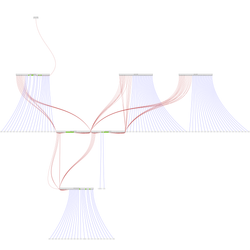...
[2] "Configuring and tuning HPE ProLiant Servers for low-latency applications": https://www.hpe.com/h20195/v2/GetPDF.aspx/c05281307.pdf
[3] https://downloads.linux.hpe.com/SDR/project/stk/
...
The cluster diagram at Cluster Intro is out of date. I created a new one using https://github.com/glaville/graphviz-infiniband-topology. It's kind of ugly but does the work for me.
24
An excellent explanation of how the NIC and its driver work collaboratively to send/receive packets: http://stackoverflow.com/questions/36625892/descriptor-concept-in-nic. The DPDK performance optimization guidelines (https://software.intel.com/en-us/articles/dpdk-performance-optimization-guidelines-white-paper) mention a bit more on DPDK-specific config options like `RX_PTHRESH`, `RX_WTHRESH`, etc.
The main problem of using TSC is that there is no obvious way to convert cycles to nanoseconds. The Intel docs state that Invariant TSC runs at a constant rate, which may differ from the processors' realtime frequency. The Linux kernel computes this TSC frequency by counting how may TSC cycles occurs between two hardware timers. The result can be displayed by `dmesg | grep TSC`. On the CloudLab m510 machines, the command above outputs something like "[ 0.000000] tsc: Fast TSC calibration using PIT ... [ 3.760036] tsc: Refined TSC clocksource calibration: 1995.379 MHz". RAMCloud currently uses `gettimeofday` to estimate the TSC frequency. To get a sense of how accurate it is, I redo the estimation using the newer `clock_gettime` with different clock sources. Here is the result:
| View file | ||||
|---|---|---|---|---|
|
It appears that clock MONOTONIC_RAW 1) gives the most consistent result across the cluster as well as multiple runs and 2) is the only one whose result matches the 1995.379 MHz computed by kernel. However, does it suggest clock MONOTONIC_RAW gives the most accurate estimate? I don't know yet.
Finally, some posts/articles that I find useful to read:
http://oliveryang.net/2015/09/pitfalls-of-TSC-usage/
http://stackoverflow.com/questions/6498972/faster-equivalent-of-gettimeofday
https://randomascii.wordpress.com/2011/07/29/rdtsc-in-the-age-of-sandybridge/
